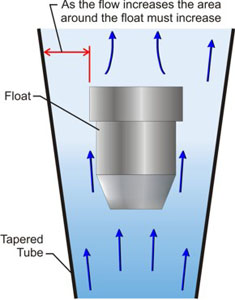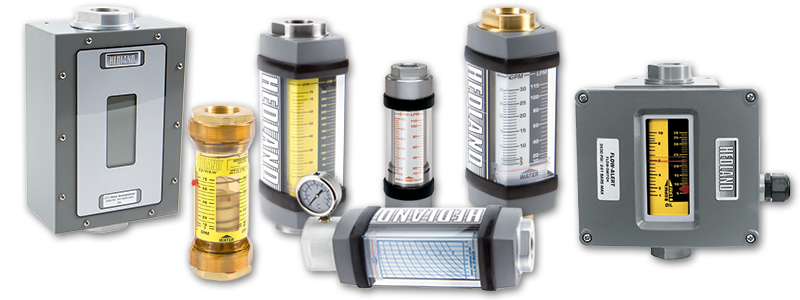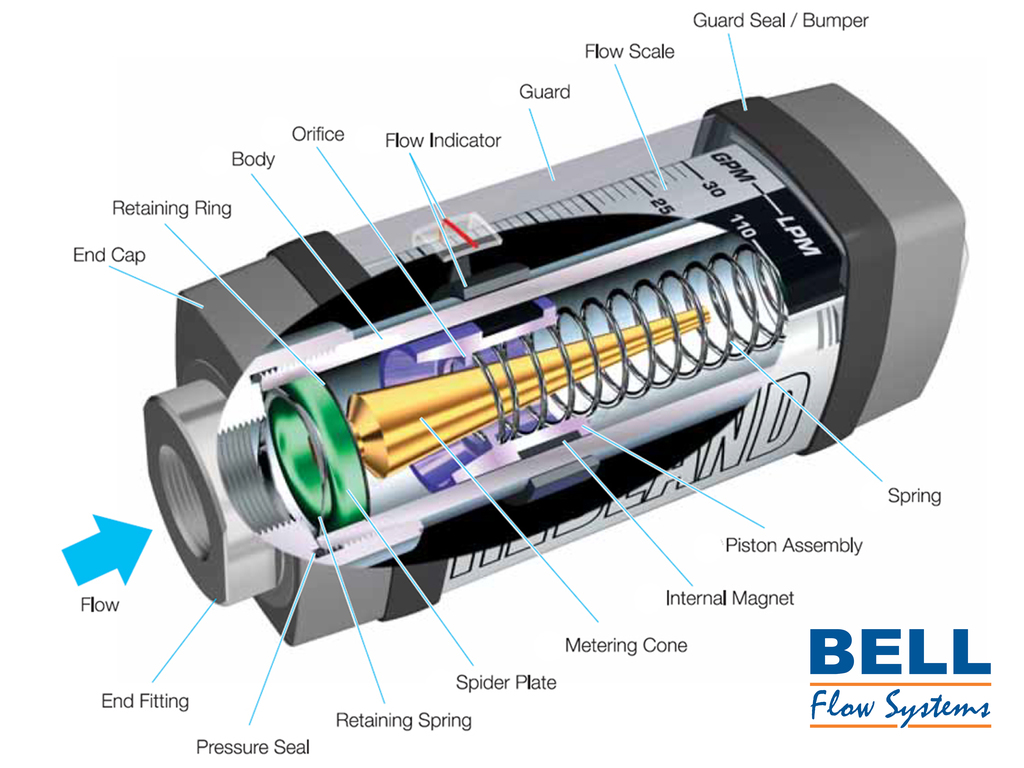Variable Area Flow Meter Guide
About Variable Area Flow Meters
This technology is simple and reliable, if not as accurate as some others. It has been used throughout industry for many years, very successfully. Variable Area flow meters come in a variety types, but essentially liquid or gas must pass through a restriction in the meter body forcing an increase in the area which is then measurable by relation.
How do Variable Area flow meters work ?
Variable area flowmeters are very simple yet versatile flow measurement devices for use on all types of liquids, gases and steam. They operate on the variable area principle, whereby a flowing fluid changes the position of a float, piston, or vane to open a larger area for the passage of the fluid. The position of the float, piston, or vane is used to give a direct visual indication of the flowrate. The variable area family of flowmeters includes the following features and

Figure 1: Rotameter Variable Area operating principle
The first variable area meter with rotating float was invented by Karl Kueppers in Aachen in 1908.
Figure 2: Spring loaded Variable Area Flow Meter Construction
Rotameters are simple industrial flow meters that measure the flow rate of liquid or gas in a closed tube. Rotameters are popular because they have linear scales, a relatively large measurement range, low pressure drop, and are simple to install and maintain. Rotameters are a subset of meters called variable area flow meters that measure the flow rate by allowing the fluid to travel through a tapered tube where the cross sectional area of the tube gradually becomes greater as the fluid travels through the tube. The flow rate inside the rotameter is measured using a float that is lifted by the fluid flow based on the buoyancy and velocity of the fluid opposing gravity pulling the float down. For gasses the float responds to the velocity alone, buoyancy is negligible.
The float moves up and down inside the rotameter's tapered tube proportionally to the flow rate of the fluid. It reaches a constant position once the fluid and gravitational forces have equalized. Changes in the flow rate cause rotameter's float to change position inside the tube. Since the float position is based on gravity it is important that all rotameters be mounted vertically and oriented with the widest end of the taper at the top. It is also important to remember that if there is no flow the float will sink to the bottom of the rotameter due to its own weight.
The operator reads the flow from a graduated scale on the side of the rotameter, which has been calibrated to a specific fluid/gas with a known specific gravity. Specific gravity or the weight of the fluid has a great impact on the rotameter's accuracy and reliability.
Rotameters can be calibrated for other fluids by understanding the basic operating principles. Rotameter accuracy is determined by the accuracy of the pressure, temperature, and flow control during the initial calibration. Any change in the density and weight of the float will have impacts on the rotameter's flow reading. Additionally any changes that would affect the fluid such as pressure or temperature will also have an effect on the rotameter's accuracy. Given this, rotameters should be calibrated yearly to correct for any changes in the system that may have occurred
There are several other styles of Variable Area flow meter available offering various functional and installated benefits including bi-directional flow measurement, resistance to pumped liquid pulsation and multi-liquid/gas scales with interpretive guidance charts for changing media values.
Advantages:
♦ Available calibrated for a wide range of media
♦ Repeatable measurement accuracy
♦ High Pressure models available for Hydraulic applications
♦ Since the area of the flow passage increases as the float moves up the Rotameter tube, the scale is approximately linear.
♦ Power is not required for operation
♦ Low and predictable pressure loss across the body
♦ Wide choice of materials
♦ Wide range of sizes & fittings available
♦ Inexpensive (Especially plastic tube rotameters)
♦ Transparent models "dual purpose" as a site glass for the media
♦ No flow conditioning required
♦ Suitable for hazardous areas
♦ Low cost of ownership
♦ Easy to install
♦ Integral needle valve for flow control in process or medical installations or back pressure creation in hydraulic Horsepower calculations
♦ Simple and proven design facilitates in-field repair
♦ Alarms and signal transmitters can be added
♦ Spring loaded VA meters can operate in any position/orientation and do not require flow straighteners or special piping
Disadvantages:
♦ Pulsating flows are not easily tolerated and will affect the readings
♦ Far more accurate technologies exist in the marketplace
♦ These meters are calibrated to a mediums S.G and cannot be used on alternative media without re-calibration
♦ Standard Rotameters must be installed in vertical pipework with upwards flow
♦ Low turndown ratio
♦ Dirty liquid may obscure readings in some more basic rotameters
♦ Sensitive to changes in temperature and pressure
♦ Large sized pipe are not catered for, typically above six inches
Typical applications:
♦ Rotameters are very commonly used as purge flow indicators for pressure and level measurement systems requiring a constant flow of purge fluid.
♦ Sharp edge spring-loaded VA meters find an ideal use in hydraulic plant monitoring applications
♦ Plastic VA Rotameters are used throughout the brewing industry
| View our range of Variable Area Flow Meters |




